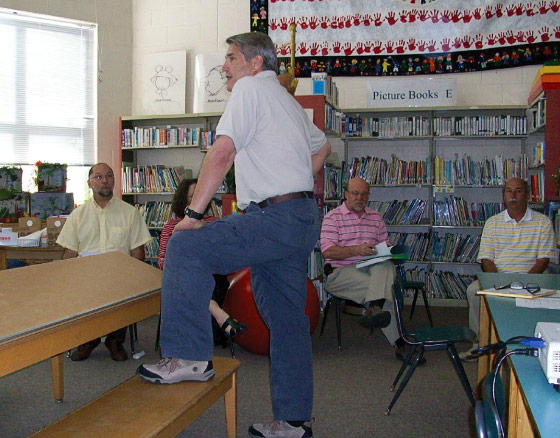School IPM Pilot Projects Take Flight
Schools Embrace IPM for All the Right Reasons
 |
|
Marc Lame (Indiana Univ.) developed the Monroe Model, which uses pilot schools as a basis for expanding the IPM approach throughout each school district. Photo by Arife Ozkan, New Hampshire Dept. of Agriculture, Markets and Food |
On a sunny April morning, thirty students squeeze themselves into chairs in a public elementary school classroom. But here in Exeter, New Hampshire, these students are school operations staff, pest control professionals, advocacy workers, extension educators, and staff from the state’s departments of agriculture, education, health, and environmental services. They have come to learn how they can bring IPM practices into schools. It’s a diverse group and a remarkable turnout.
School IPM deserves the attention and enthusiasm it has sparked in New Hampshire. Children are more vulnerable than adults to both pests and pesticides, either of which can trigger asthma, the leading chronic illness in U.S. children. Studies show that IPM schools can have up to 90 percent fewer pest problems and pest-related allergens, and significantly less pesticide use and pesticide residues on exposed surfaces.
Nationwide, there’s a push to make IPM the standard practice in all schools by 2015. The case for change is compelling, but making it real is a complex task involving “change agents” in every region, state, and school district.
The northeastern School IPM Working Group, led by Lynn Braband (NYS IPM Program) and Kathy Murray (Maine Dept. of Agriculture), is doing its part to achieve the national goal by helping to organize pilot events like the one in Exeter, and by gathering members who will support the move toward school IPM in each state in the region.
The New Hampshire workshop was based on the Monroe Model for implementing school IPM, which emphasizes raising awareness throughout the school community and securing commitments from key change agents––the kinds of folks who attended this workshop.
In Rhode Island, a similar pilot project is taking shape in the Chariho School District. Chariho’s workshop, also held in April, was based on the STAR Certification Model. Developed by the IPM Institute of North America, the STAR program focuses on IPM training, assessments, and implementation plans that enable schools to verify that IPM is indeed being used.
The movement toward school IPM is happening in all states throughout the region, some of which developed model school IPM plans years ago or already require the use of IPM in schools.
With the national school IPM goal now framed in a specific timetable, the regional working group aims to ensure that every state, every district in the Northeast, is adopting an IPM approach to ensure a healthy environment for learning.
— by ELIZABETH MYERS
The Northeastern IPM Center promotes integrated pest management for reducing risks to human health and the environment. If republishing our news, please acknowledge the source (“From Northeast IPM Insights”) along with a link to our website.
